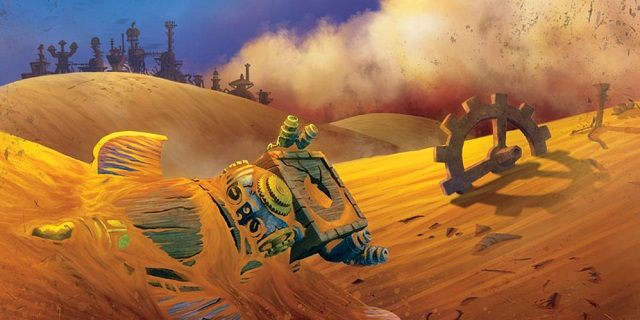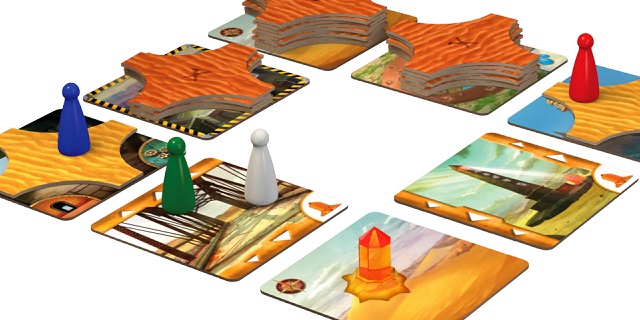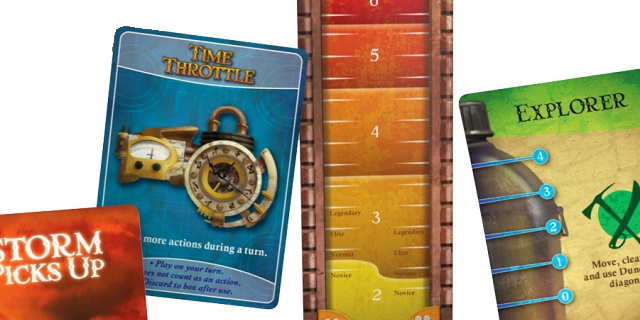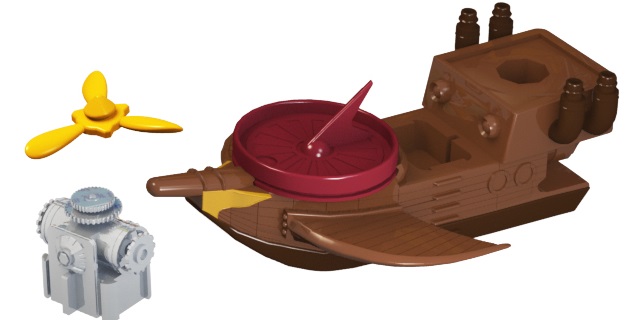
Matt Leacock has a knack for designing cooperative board games. The creator of both Pandemic and Forbidden Island is back with a spiritual sequel to the latter in Gamewright’s Forbidden Desert. The streamlined design and ease of access to Forbidden Desert might just make it his best yet.
Where the problem in Forbidden Island was too much water, Forbidden Desert turns water into a precious resource, as your band of adventurers has found itself stranded in the middle of the very sea of sand they were planning to investigate. A monstrous sandstorm crashed your helicopter (my friends and I like to imagine it was the same one you used to escape Forbidden Island), and now what was originally an expedition to discover an ancient city and its rumored flying machine has now become your only hope of survival. The journey will not be easy.
Forbidden Desert consists of 24 tiles laid out randomly in a five-by-five grid, with the center space vacant to represent the current location of the sandstorm. One of these tiles represents your crash site and is where everyone will begin, three more are potential oases, and the rest are just unmarked tracts of endless sand. Your mission is to excavate the ruins of the ancient city to find the pieces of the flying machine and bring them to the launch pad – which must also be excavated – before being buried by the storm or claimed by your thirst.

Each player gets up to four actions. These actions can be used to clear a layer of sand from their tile (or an adjacent one), to move from one tile to an adjacent one (as long as the destination is unblocked by too much sand), to excavate a cleared tile or to pick up one of the discovered parts of the flying machine from its excavated tile. Players may also pass gear or share water without spending an action. As in Leacock’s other titles, each player is randomly assigned a special role, bestowing additional abilities that are crucial to your success. Players’ roles also determine the size of their water canteen.
An excavated non-oasis tile will flip to reveal one of four outcomes: a normal part of the city that simply holds a piece of gear, represented by a random draw from the equipment deck; a tunnel, adjacent to other tunnel tiles and providing both cover from the harsh sun and a piece of gear; the launch pad; or a clue to one of the flying machine parts. These clues come in pairs, one indicating a column and one indicating a row. Once both clues to a given part are excavated, the corresponding piece is placed on the tile located at the intersection (or, rarely, the vacant space currently occupied by the storm). Two of the three oasis tiles represent a well that, when excavated, grants all players on the tile two levels of water. The third? Is nothing but a mirage, an action wasted. Be warned.
Following each player’s turn, the storm will be active. That player reveals a number of storm cards equal to the current level of the storm meter. Three of these cards will increase the intensity of the storm. As the storm reaches certain thresholds, the number of cards drawn each turn will rise, and if the storm becomes too intense, the players will be swept away and lose the game. Four storm cards represent the beating down of the unyielding sun, and any players not protected by a tunnel or piece of gear must lose one level of water for each such card drawn. If any one player has no water when this happens, he dies and the entire team loses.

The rest of the storm cards indicate the intensity and direction of the wind. For each square on the card, shift one tile into the vacant space of the grid from the direction indicated. Each tile moved this way gains a layer of sand. Two or more layers of sand will block any and all movement to or from that tile. A player buried this way must spend actions to clear sand before they can do anything else. Should you need to place a sand marker and there are none left, the players are buried by the storm and lose.
This shifting of tiles is what really makes Forbidden Island shine, as your carefully-planned actions can quickly be thwarted by an unexpected shift or a sudden appearance of a wall of sand. Since the storm can move as many as three tiles per card, the board can theoretically look very different from one turn to the next. Somewhat on the players’ side, however, is the fact that if the storm is on the edge of the grid and the wind moves in from that edge, no tiles are moved and no sand is added. Also in the players’ favor is the fact that the amount of Sun Beats Down cards is a known quantity, so they can judge their risk of thirst and hopefully plan accordingly.
As with Forbidden Island, Gamewright as really put together an amazing package for Forbidden Desert. The flying machine pieces, which includes the toy-like hull in addition to the four that must be found (presumably the hull is located at the launch pad), are great models similar to the treasures of Island, and really make the game stand out from its wooden cube-bearing brethren. The tiles and sand tiles are the same quality cardboard as used in Island as well. Plastic clips to indicate each player’s water level and the current intensity of the storm are a little fiddly but fine.

All of these components, plus the cards and wooden player pawns, are packaged in a tin box also reminiscent of Island. Unfortunately there is an issue with the card well that often leaves the last few cards trapped at the bottom of it, requiring significant effort to free safely. Still, that is quite possibly the only flaw in this incredible presentation, as Gamewright continues to make its games stand out on the shelves. Also standing out? The insane bargain price of a mere $25.
Forbidden Desert might just become my go-to title for (non-superhero) cooperative play, as there is no awkward hand management like Leacock’s previous titles, no reliance on dice and nothing in the game that isn’t intuitive. Also, in contrast to both Forbidden Island and a non-expanded Pandemic, Forbidden Desert supports five players right out of the box (er… tin). The desert might be forbidden, but this game cannot be recommended enough.



















